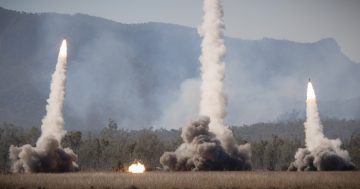
A Kongsberg NSM is launched from a US Navy Independence-class LCS. Photo: US Navy.
The Commonwealth has signed a contract with Norwegian company Kongsberg to buy the Naval Strike Missile (NSM) to equip the Royal Australian Navy’s 12 ANZAC and Hobart class warships. It has confirmed it will buy the land-based Lockheed Martin M142 HIMARS missile system for the Australian Army.
Under the Navy’s Project SEA 1300, the NSM will replace the RGM-84 Harpoon missile in the anti-shipping role, effectively doubling the range of the ageing Harpoon in a much stealthier and ‘smarter’ weapon package. Like the Harpoon, the NSM is launched from deck-mounted canisters. The system is currently in service, or on order, for the navies of Norway, Malaysia and Canada.
There are also fixed and mobile land-launched versions of the NSM in service with Poland and the US Marine Corps, while in Australia, Kongsberg Australia and Thales Australia are pitching the locally developed Strikemaster concept, which mounts two NSM canisters on the back of a Bushmaster-protected military vehicle for the Australian Army’s Project LAND 4100 Phase 2 deployable land-based anti-ship system requirement.

US Army M142 HIMARS systems deployed to Australia for Exercise Talisman Saber. Photo: ADF.
An air-launched version of the NSM – the JSM – is also being considered by the Commonwealth to possibly equip the Royal Australian Air Force’s Lockheed Martin F-35A and Boeing F/A-18F strike aircraft.
“In the current strategic environment, it’s important the Australian Defence Force is equipped with high-end, targeted military capabilities,” Deputy Prime Minister and Minister for Defence Richard Marles said in a 5 January statement.
“The Albanese Government is taking a proactive approach to keeping Australia safe – and the Naval Strike Missile and HIMARS launchers will give our Defence Force the ability to deter conflict and protect our interests.”
The M142 High Mobility Artillery Rocket System (HIMARS) is a truck-mounted precision rocket artillery system. To be acquired under the Project LAND 8113 requirement, the HIMARS rockets are GPS-guided. They are designed to be employed against infrastructure, command and control centres, and other fixed targets in rear areas.

A HIMARS unleashes a volley of GLMRS rockets during Exercise Talisman Saber in Queensland. Photo: ADF.
The system can launch six M30/M31 Ground Launched Multiple Rocket Systems (GLMRS) rockets out to 100 km or a single M57E Army Tactical Missile System (ATACMS) out to 300 km. It is air-transportable via Royal Australian Air Force C-130J or C-17 transport aircraft or can be deployed by Royal Australian Navy or Australian Army amphibious vessels.
Australia is also a cooperative development partner in the US Army’s new Precision Strike Missile (PrSM) program, which will enter service in 2024. An advanced development of the ATACMS missile with a range beyond 500 km, the PrSM will be capable of hitting fixed or moving targets on land or at sea and is designed to be fired from the HIMARS launcher.
“The Albanese Government is getting on with delivering the Australian Defence Force the capability it needs for the 21st century. The level of technology involved in these acquisitions takes our forces to the cutting edge of modern military hardware,” Minister for Defence Industry Pat Conroy said.
“The Naval Strike Missile is a major step up in capability for our Navy’s warships, while HIMARS launchers have been successfully deployed by the Ukrainian military over recent months and are a substantial new capability for the Army.”

The Australian-developed Strikemaster system combines the chassis of a Thales Australia Bushmaster vehicle with two Kongsberg NSM missile canisters. Photo: Thales Australia/Kongsberg Australia.
HIMARS’ most recent reported success in Ukraine was against a temporary Russian barracks on New Year’s Day when four missiles hit the converted college, destroying a Russian ammunition dump and the reported loss of between 63 and 200 soldiers.





















